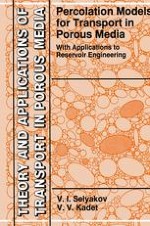1996 | OriginalPaper | Chapter
Percolation Model of Fluid Flow in Heterogeneous Media
Authors : V. I. Selyakov, V. V. Kadet
Published in: Percolation Models for Transport in Porous Media
Publisher: Springer Netherlands
Included in: Professional Book Archive
Activate our intelligent search to find suitable subject content or patents.
Select sections of text to find matching patents with Artificial Intelligence. powered by
Select sections of text to find additional relevant content using AI-assisted search. powered by
Numerous cases of violation of the linear Darcy’s law, which claims that the value of flux (flow rate) is directly proportional to the pressure gradient, has been observed. For very small flow velocities (pressure gradients) these deviations are caused by the formation of bounded fluid layers on the pore (capilliary) surfaces [50, 51]. For relatively large velocities, deviations are caused by turbulence in the flow in pores (capillaries) and by the fluid kinetic energy losses on heterogeneities like capillary junctions, etc. [51, 52]. For sufficiently homogeneous media, it is possible to average the law describing flow at the micro level over the whole volume of the medium to extend it to the macro level [47]. However for some heterogeneous media, such an operation is not valid [52]. Indeed, if r1 and r2, the radii of two successive capillaries, differ by an order of magnitude, then the local pressure gradients in them (for example, in the case of Poiseuille flow through the capillaries) are to one another as (r1/r2)4, i.e., differ by a factor of 104. In such a medium, all types of flow can take place at the micro level, namely the flow with the larger part of the pore space filled with bounded fluid; Poiseuille flow; transient flow from laminar to turbulent; and turbulent flow.
